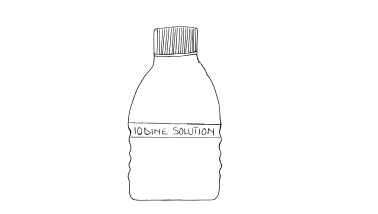Chapter: Biology Practicals: Laboratory Equipment
Making Biology Solutions - Biology Laboratory Practicals
Making Biology Solutions
Activities in the topics of Nutrition and Respiration require specific analytical solutions. In this section you will find materials and instructions on how to prepare common solutions for the Biology laboratory.
For local and low cost sources of the chemicals mentioned in these prepa-rations, see the section on Sources of Chemicals.
Benedict's Solution
Description: Bright blue solution
Use: To test for reducing and non-reducing sugars
Result: Gives orange precipitate when boiled with reducing sugar
Hazard: Copper ions are poisonous if they enter the body. Use tools to avoid contact between copper (II) sulphate and skin. Wash hands after using this chemical.
Procedure: Dissolve 5 teaspoons of sodium carbonate, 3 teaspoons of citric acid, and one teaspoon of copper sulphate in half a litre of water. Shake until everything is fully dissolved.
Note: The addition of the citric acid and sodium carbonate should be done slowly as they cause e ervescence when mixed quickly.
Calcium Hydroxide Solution (Lime Water)
Description: Opaque white liquid
Use: To test for CO2
Result: This liquid will change from clear to cloudy if CO2 is present.
Procedure: Add 3 spoonfuls of white cement into about half a litre of water. Stir the solution and let it settle. Decant the clear solution and transfer it to a reagent bottle.
Citric Acid Solution
Description: Colourless solution
Use: To hydrolyse non-reducing sugars to reducing sugars
Procedure: Dissolve 2 1/2 spoonfuls of citric acid in half a litre of water.
Copper Sulphate Solution
Description: Light blue solution
Use: To test for proteins, to prepare Benedict's Solution
Result: Gives a purple colour when combined with NaOH in protein solution
Hazard: Copper ions are poisonous if they enter the body. Use tools to avoid contact between copper (II) sulphate and skin. Wash hands after using this chemical.
Procedure: Dissolve 1 spoonful of CuSO4 crystals in 1/2 litre of water. Dis-solve the CuSO4 completely.
Iodine Solution
Description: Light brown solution
Use: To test for starch and lipids
Result: Gives a red ring with lipids and a black-blue with starch
Procedure: Dilute 1 part concentrated iodine tincture with 9 parts water. Keep the solution in a labelled reagent bottle.

Figure 3.1: Iodine solution can be easily prepared and stored for later use.
Sodium Hydroxide Solution
Description: Slightly cloudy white solution
Use: To test for proteins
Result: Gives a purple colour when combined with CuSO4 in protein solution Hazard: Corrodes metal, burns skin, and can blind if it gets into the eyes
Procedure: Combine 1 spoon of NaOH with 1/2 litre of water.
Local manufacture: Burn dry grass and collect the ash. Dissolve 3 spoonfuls of ash into a litre of water. Stir the solution and let it settle. Decant the solution, then place the solution in a labelled reagent bottle.
Note: Local manufacture is not very practical because it will make a very dilute solution. This can be performed just to demonstrate the nature of ashes. It is best to buy industrial caustic soda.
Related Topics